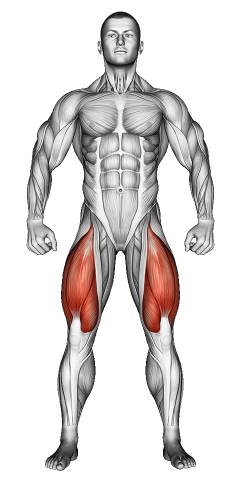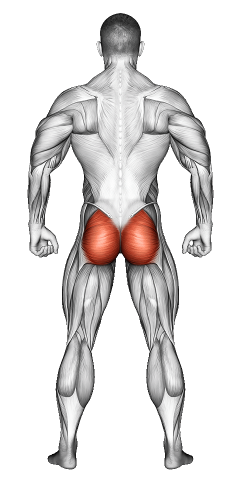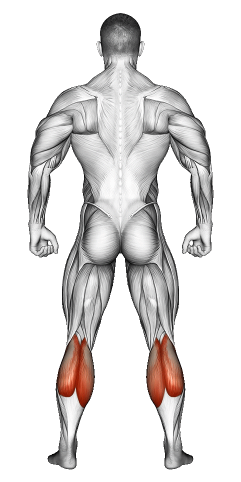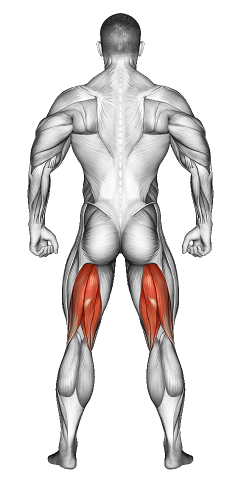Squats: Video Tutorial & Exercise Guide

Written By: Claude Michael
Updated: Oct 13, 2024
| Workout | Squats |
| Primary Muscle Group | Quads |
| Secondary Muscle Group | Calves, Hamstrings Glutes |
| Equipment Required | Bodyweight |
| Force Type | Push |
| Mechanics | Compound |
| Exercise Type | Strength |
| Difficulty | Beginner |
Squats: Video Tutorial & Exercise Guide
Secondary Muscles Group
Squats: Step-by-Step Guide
- Step 1: Stand with your feet shoulder-width apart, toes slightly pointed outward. Keep your chest lifted and your core engaged.
- Step 2: Start the movement by pushing your hips back, as if sitting down into a chair. Bend your knees and lower your body until your thighs are at least parallel to the floor, or as low as your mobility allows.
- Step 3: Keep your knees aligned with your toes and ensure they do not cave inward. Distribute your weight evenly across your feet, keeping your heels grounded.
- Step 4: Push through your heels to return to the standing position, straightening your legs and squeezing your glutes at the top of the movement.
- Step 5: Repeat for the desired number of reps, maintaining proper form and control throughout the exercise.
Squat: Overview
The squat is one of the most fundamental and effective lower-body exercises, targeting multiple muscle groups, including the quadriceps, hamstrings, glutes, and calves. It’s a compound movement that builds strength, muscle mass, and endurance while also improving flexibility and mobility in the hips and knees.
Squats are highly versatile and can be performed with bodyweight, barbells, dumbbells, kettlebells, or resistance bands. They can be modified to suit any fitness level, from beginners to advanced athletes, and are essential for building a strong, functional lower body.
Squats: Benefits
Squats are an excellent way to build lower-body strength and muscle mass, particularly in the quadriceps, hamstrings, and glutes. They also engage the core muscles, improving stability and balance.
This exercise helps improve functional fitness, as the movement mimics everyday actions like sitting, standing, and lifting. Squats can enhance athletic performance, particularly in sports that require running, jumping, or quick changes in direction.
Squats are also effective for boosting metabolism and burning calories, making them a valuable addition to fat-loss programs. Additionally, squats can help improve mobility and flexibility in the hips, knees, and ankles.
Squat: Pro Tips & Advanced Techniques
Keep your chest up and core engaged throughout the movement to maintain proper posture. Focus on driving through your heels to fully engage your glutes and avoid letting your knees cave inward. For an added challenge, you can add resistance by holding dumbbells or using a barbell across your shoulders, or try variations like the jump squat or pistol squat. Ready to strengthen your lower body? Let’s squat!
Squats: Progression Plan
Beginner
Intermediate
Advanced
Squats: Frequently Asked Questions (FAQs)
What muscles do Squats target?
+Squats primarily target the quadriceps, hamstrings, and glutes. They also engage the calves and core muscles to help with stability during the movement.
Are Squats suitable for beginners?
+Yes, squats are suitable for beginners. Start with bodyweight squats to master proper form and range of motion before adding resistance like dumbbells or barbells.
How can I make Squats more challenging?
+To increase the difficulty, add weights such as dumbbells or a barbell. You can also incorporate squat variations like jump squats or pistol squats for added intensity.
How often should I include Squats in my routine?
+Squats can be included 2-3 times per week as part of your lower body or full-body workout. They can be paired with other compound movements like lunges or deadlifts for a comprehensive leg workout.
What common mistakes should I avoid when doing Squats?
+Avoid letting your knees cave inward or your chest drop forward during the squat. Keep your knees aligned with your toes, your chest up, and your core tight throughout the movement for proper form.
Share
Don’t Wish for It, Work for It – Join the FlexXP Newsletter Today!
Thank you for signing up for the FlexXP Newsletter!
This site is protected and the Google Privacy Policy and Terms of Service apply.



